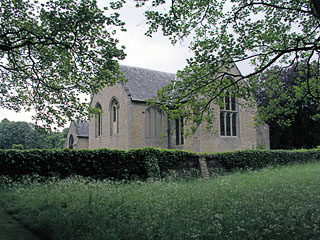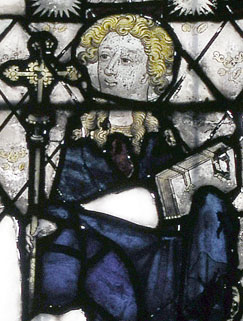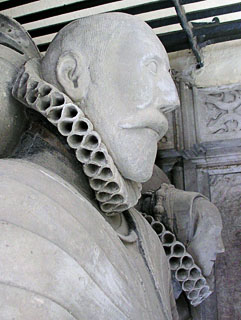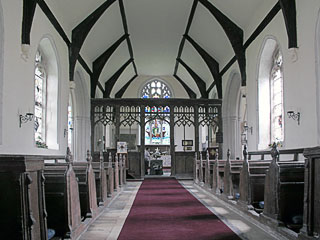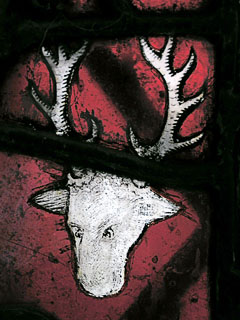We rode westwards out of Snailwell, looking for Landwade. I was determined to visit at least one church in Suffolk on our outing, and according to the OS map, Landwade was on the northern edge of the little island of Suffolk that surrounds Newmarket.
I hear you ask: 'This is a website about Cambridgeshire churches, isn't it?' Very true. But Landwade is a very recent addition to Suffolk. It was always a small place - the church effectively served as a private chapel to the hall, as we will see - and so in 1953 it was united with Fordham, the neighbouring Cambridgeshire parish. For some reason, though, in 1994 it was detached from Fordham and transferred to Exning, the nearest Suffolk parish. So, Landwade moved across the county border, which now runs round the northern edge of the estate. So, now you know.
It's not an easy place to find. One comes off the A142 from Soham to Newmarket and the road turns left almost immediately, passing along the outer boundary of the Landwade estate. Save for a private road about half way down, though, and a rather implausible little lane, there are no signs of habitation. The implausible lane, leads to a little row of houses facing out over the fields (shadowed by storms, when we visited). An unmetalled track leads off to the right. Somewhat to our surprise, we found that this is in fact the driveway of the hall. We could see the church through the trees ahead of us, but it did feel peculiar parking in front of someone's rather grand house.
The rain was returning, though, and nobody was about, so we made a run for it.
The church sits at the end of the garden of Landwade Hall. As we tramped past the conservatory, visions of red faced earls with blunderbusses passed my eyes. Still, the back of the house was just as lifeless as the front had been, and the church was very enticing. It sits in a graveyard enclosed by low walls gradually disintegrating under great banks of ivy. The exterior was unremarkable, but cheery - a production of the 15th century in all parts, from its low tower to the compact, square body.
We got into the porch, but discovered that the door was locked. That didn't matter, really; we sat and ate some bread and cheese, and drank Norman cider, and waited for the rain to pass. It started to fade, and the sun came out, filling the air with brightness and burnishing the grass and oak trees to a green glory. We noted the old moat next door to the church, which has a nice old bridge across it and once embraced the old hall. We would have been thoroughly satisfied - after all, it was getting on for half past six, so expecting anywhere still to be open was a bit optimistic.
The Snail, though, had a visitor. At first I thought it was a cat (in our experience the Snail is a big hit with cats - they like to sit on the back seat, and in the past we've come out of a church to discover little paw prints all over the back box), but as we got closer it turned out to be a tiny little terrier. Its owner soon appeared too. Blunderbusses at the back of my mind, I waited rather nervously for him to come and tell us to get off his bloody drive.
Serves me right for making assumptions, I suppose. He was rather elderly and posh, and dressed in a tatty fleece and baseball cap. He stood and chatted with us about the bike for a while, never actually asking us while we were there. Eager to demonstrate our good intentions (and to hide the garden statuary I thought he might suspect we were taking to sell on the Cambridge black market) we dropped various references about church-spotting:
'That's a nice machine you've got there - is it efficient?'
'Oh yes, yes, it is - very good for pottering around looking at churches, and very efficient, yes!'
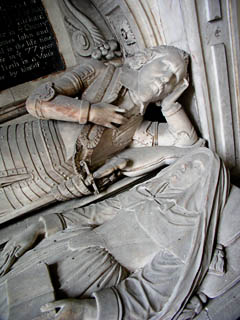 |
After a while he obviously decided that we had no nefarious intentions and offered to fetch the key for us. We were lucky that he did. Landwade has some of the most complete early glass in the county - much of it fragmentary, of course, but many figures are almost complete: one saint has a scroll saying 'In Spiritu Sanctum', which is rather a rare survival. Much of it is 15th century, put in when the church was first built. There is also an elegant Perpendicular screen, some nice bearded heads on the chancel roof corbels, and a little stoup by the north door.
The main interest, though, is the profusion of tombs clustered in side aisles and around the altar. In the chancel sit three tomb chests, devoid of any markings save the shadows of the memorial brasses. One sits right in front of the altar. The post-reformation tombs appear in the side chapels. Landwade was the possession of the Cotton family and they lived in the hall from before the Reformation until about 1750, when they moved across the county to Madingley. One presumes that the chancel tombs are theirs - they were obviously a prosperous bunch.
In the north chapel there is a splendid Elizabethan monument to Sir John Cotton and his wife Isabell (née Spencer) who died in 1593 aged 81 and 1578 aged 63 respectively. They recline, side by side, stiff with slightly doll-like faces. The complex folds of Lady Isabell's petticoats, though, are captured in very realistic detail. Their descendents are scattered around the south chapel - their son Sir John Cotton (d. 1620 at the age of 77) and his wife Elizabeth, and presumably a great-grandson John Cotton (d. 1689 at 74), created baronet in 1641 for spiriting some college plate from Cambridge away to King Charles at Oxford. Pevsner remarks that his tomb is 'very reactionary' - given that they all had the same name until at least until 1712 (a final John Cotton has a memorial commemorating his death in that year) that seems entirely in character.
We left at about 7.30pm and I dropped the key through one of the myriad side doors - it was answered by furious barking from the terrier, but the house remained silent and still. The trees swayed in the wind, and the clouds were touched with gold in the western sky, over the green of the oak and ash and thorn. Landwade is isolated, and it's rather odd having to park in someone's drive, but it's worth it.
St Nicholas was locked when we visited, but there is a key at the house
